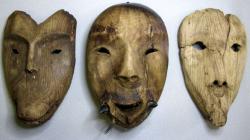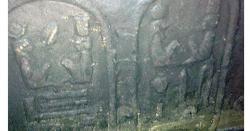INSTITUT SUPERIEUR D'ANTHROPOLOGIE
INSTITUTE OF ANTHROPOLOGY
ONLINE COURSES / COURS A DISTANCE
SUMMER TERM : JULY 2017
REGISTER NOW
USA –  Monmouth - A lead musket ball recovered from Monmouth Battlefield Park has tested positive for human blood protein. Members of the Battlefield Restoration and Archaeological Volunteer Organization collect musket balls in an effort to learn more about the positions of the Continental Army and British troops during the battle, fought in June 1778. This musket ball in particular is thought to have been used as canister shot—one of many balls stuffed in a tin canister and fired from a cannon.
Monmouth - A lead musket ball recovered from Monmouth Battlefield Park has tested positive for human blood protein. Members of the Battlefield Restoration and Archaeological Volunteer Organization collect musket balls in an effort to learn more about the positions of the Continental Army and British troops during the battle, fought in June 1778. This musket ball in particular is thought to have been used as canister shot—one of many balls stuffed in a tin canister and fired from a cannon.
http://www.nj.com/monmouth/index.ssf/2017/05/human_blood_found_on_revolutionary_war_artifact_fr.html
USA – Alexandria - The City of Alexandria has announced that archaeologists under contract with a developer have found burial remains appearing to represent two individuals, at the construction site in Old Town where Robinson Terminal South was previously located. The finding is consistent with the use of the site in the 1700s and 1800s, when the deceased were not always buried in cemeteries.
https://www.alexandrianews.org/2017/05/city-of-alexandria-announces-archaeological-discovery-of-early-burial-remains/
PAKISTAN – Mohenjo Daro - International archaeologists are trying to save Pakistan's lost city of Mohenjo Daro built during the Bronze Age and built by the Indus Valley people around 3,000 BC.
VIDEO = http://www.dailymail.co.uk/video/sciencetech/video-1467811/Archaeologists-trying-save-Pakistan-s-lost-city-Mohenjo-Daro.html
ALASKA –  Nunalleq - More than 50,000 frozen Alaskan artefacts are to be returned home after being preserved by archaeologists at the University of Aberdeen.The team has spent more than seven years recovering and preserving the objects at Nunalleq.They faced a race against the clock in the face of melting ice to save the frozen artefacts. Once removed from the earth, they began to deteriorate quickly so the team had to act quickly. The collection is thought to be one of the largest of its kind from a single site in Alaska.
Nunalleq - More than 50,000 frozen Alaskan artefacts are to be returned home after being preserved by archaeologists at the University of Aberdeen.The team has spent more than seven years recovering and preserving the objects at Nunalleq.They faced a race against the clock in the face of melting ice to save the frozen artefacts. Once removed from the earth, they began to deteriorate quickly so the team had to act quickly. The collection is thought to be one of the largest of its kind from a single site in Alaska.
http://www.bbc.com/news/uk-scotland-north-east-orkney-shetland-39973667
EGYPTE –  Abydos - An Egyptian archaeological committee from Al-Belinna inspectorate in the Sohag town of Abydos found a stone block engraved with the cartouche of the 30th Dynasty King Nectanebo II during the inspection of an old house in the Beni Mansour area, under which the owner was carrying out an illegal excavation. Abul Azm added that the block may have been part of King Nectanebo II's royal shrine or an extension of a wall of a temple built by the king. Nectanebo II is well-known for his construction projects in Abydos. pointed out that the newly discovered block measures 1.40x40 cm, but the high level of subterranean water has made it difficult to determine whether it was part of a shrine or a temple wall.
Abydos - An Egyptian archaeological committee from Al-Belinna inspectorate in the Sohag town of Abydos found a stone block engraved with the cartouche of the 30th Dynasty King Nectanebo II during the inspection of an old house in the Beni Mansour area, under which the owner was carrying out an illegal excavation. Abul Azm added that the block may have been part of King Nectanebo II's royal shrine or an extension of a wall of a temple built by the king. Nectanebo II is well-known for his construction projects in Abydos. pointed out that the newly discovered block measures 1.40x40 cm, but the high level of subterranean water has made it difficult to determine whether it was part of a shrine or a temple wall.
http://english.ahram.org.eg/NewsContent/9/40/269035/Heritage/Ancient-Egypt/Ancient-stone-block-discovered-at-illegal-excavati.aspx
ROYAUME UNI – South Muskham - Archaeologists from the University of Central Lancashire have completed a two-week dig near Newark to investigate a 370-year-old civil war site. A redoubt — a 15metre square earthwork at Crankley Lakes Camping and Caravan Park, near South Muskham — is a scheduled ancient monument and is thought to have been used as a cannon battery by Scots assailing the town during its third siege in 1645, when the Royalist outpost was surrounded by 16,000 troops. It is known that the monarch ordered defences to be built around Newark to protect the Great North Road and River Trent during the rebellion against his religious reforms called the Pilgrimage of Grace. “We have also found pottery from that period on site and if we could prove the Henry VIII link that would be an amazing discovery of national significance,” Dr Askew said.
http://newarkadvertiser.co.uk/news/2017/05/18/university-team-delves-into-newark's-civil-war-past
CHINE –  Guyuan - A team of archaeologists have discovered 13 sites that have hundreds of Neolithic artefacts in China. As per reports in Xinhua news agency, the 13 sites, in the city of Guyuan, in Ningxia Hui region, include tombs, kilns and cave dwellings, human bones, and pottery utensils and fragments of red and black pottery, Ma Qiang with the Ningxia Regional Institute of Cultural Relics and Archaeology said,"The sites have been linked to the Qijia culture, around 4,000 years ago, which was a transitional period from the Neolithic to the Bronze Age." Archaeologists also discovered 10 sites containing artefacts and tombs from the Zhou Dynasty (1046-221 B.C.), which could be used by researchers concerned with the relationship between ethnic minorities and the Great Wall.
Guyuan - A team of archaeologists have discovered 13 sites that have hundreds of Neolithic artefacts in China. As per reports in Xinhua news agency, the 13 sites, in the city of Guyuan, in Ningxia Hui region, include tombs, kilns and cave dwellings, human bones, and pottery utensils and fragments of red and black pottery, Ma Qiang with the Ningxia Regional Institute of Cultural Relics and Archaeology said,"The sites have been linked to the Qijia culture, around 4,000 years ago, which was a transitional period from the Neolithic to the Bronze Age." Archaeologists also discovered 10 sites containing artefacts and tombs from the Zhou Dynasty (1046-221 B.C.), which could be used by researchers concerned with the relationship between ethnic minorities and the Great Wall.
http://zeenews.india.com/science/archaeologists-discover-neolithic-relic-sites-in-china-2006648.html
U.A.E. -  Fujairah - Bidiya Mosque in Fujairah, the UAE’s oldest, was built more than 150 years later than was originally thought, thanks to a scientific dating performed on the blocks of coral used in its construction. The mosque, which till now was believed to date to the 1400s, now has a more probable timeframe — the year 1599.
Fujairah - Bidiya Mosque in Fujairah, the UAE’s oldest, was built more than 150 years later than was originally thought, thanks to a scientific dating performed on the blocks of coral used in its construction. The mosque, which till now was believed to date to the 1400s, now has a more probable timeframe — the year 1599.
http://gulfnews.com/news/uae/culture/uae-s-oldest-mosque-is-150-years-younger-1.2028861
CHINE - Linzhang - A relic site in China’s Hebei province has been confirmed as a royal temple built over 1,400 years ago. The base of a wooden pagoda, which archaeologists believe was built between 553 and 577, was unearthed in Linzhang county, Xinhua news agency reported.“The pagoda was part of Dazhuangyan Temple,” said He Liqun, from the Institute of Archaeology of the Chinese Academy of Social Sciences. Dazhuangyan was a royal temple in Northern Qi Dynasty (550-557). “During that dynasty, emperors followed Buddhism, and there were 40,000 temples, as well as 2-3 million monks and nuns,” said Huang Hao, editor-in-chief of the local chronicles. A tomb with an epigraph linking it to the Dazhuangyan Temple was found in the 1990s. Archaeologists searched the area surrounding the tomb and began excavation of the temple site in 2012. Archaeologists also found a stone box with crystal, jade, agate and amber, which they believe to be a Buddhist burial artefact.
https://www.canindia.com/relic-site-in-china-is-1400-year-old-royal-temple/
COREE DU SUD –  Gyeongju - Two skeletons dating from the 5th century were found under the walls of the Wolseong, or Moon Castle, in Gyeongju in South Korea, the capital of the former Silla kingdom, Seoul's Cultural Heritage Administration said in a statement. "This is the first archaeological evidence that folklore about humans being sacrificed for the foundations of buildings, dams or walls were true stories," spokeswoman Choi Moon-Jung of the Gyeongju National Research Institute of Cultural Heritage told AFP.The burial of living victims with dead kings to serve them in the afterlife is well known in ancient Korean cultures. The two skeletons were found side by side under a western corner of the castle's earth and stone walls, with one facing upward, the other turning its face and arms slightly towards the first. The Silla kingdom was one of three that emerged on the Korean peninsula in the first millennium, eventually conquering the other two to unify the territory in 668. It later split up and was finally overwhelmed in 935. DNA and other tests were being carried out on the remains to determine their physical characteristics, health, diet and genetic attributes. Other finds included wooden inscription tablets and 6th-century animal and human figurines, including one whose turban and clothing appeared similar to those worn in the ancient Central Asian civilisation of Sogdiana.
Gyeongju - Two skeletons dating from the 5th century were found under the walls of the Wolseong, or Moon Castle, in Gyeongju in South Korea, the capital of the former Silla kingdom, Seoul's Cultural Heritage Administration said in a statement. "This is the first archaeological evidence that folklore about humans being sacrificed for the foundations of buildings, dams or walls were true stories," spokeswoman Choi Moon-Jung of the Gyeongju National Research Institute of Cultural Heritage told AFP.The burial of living victims with dead kings to serve them in the afterlife is well known in ancient Korean cultures. The two skeletons were found side by side under a western corner of the castle's earth and stone walls, with one facing upward, the other turning its face and arms slightly towards the first. The Silla kingdom was one of three that emerged on the Korean peninsula in the first millennium, eventually conquering the other two to unify the territory in 668. It later split up and was finally overwhelmed in 935. DNA and other tests were being carried out on the remains to determine their physical characteristics, health, diet and genetic attributes. Other finds included wooden inscription tablets and 6th-century animal and human figurines, including one whose turban and clothing appeared similar to those worn in the ancient Central Asian civilisation of Sogdiana.
http://www.france24.com/en/20170516-ancient-human-sacrifice-discovered-korea